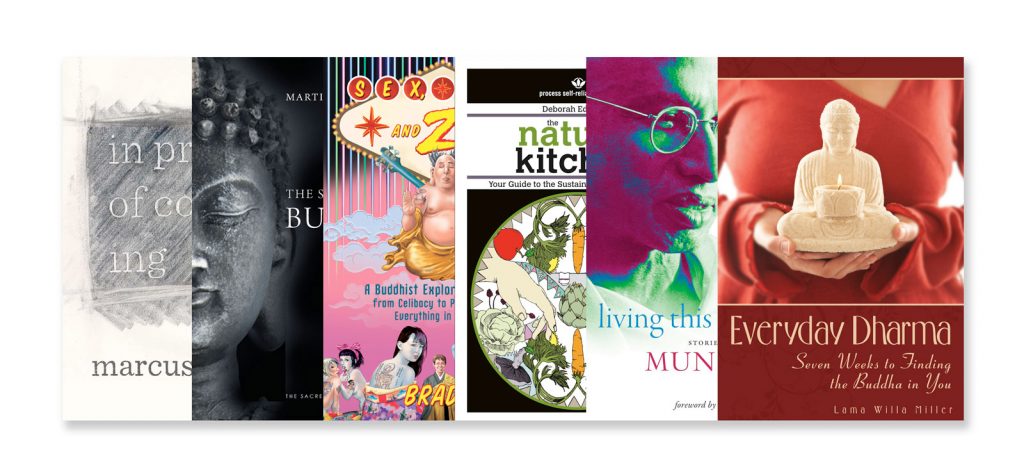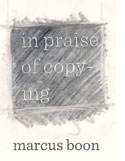 How was Copia, the Roman goddess of abundance, reduced to the modern, pejorative copycat? How can we return her to her former glory? Believe it or not, the answers to these bizarre questions might help reveal universal, vital human truths. According to Marcus Boon’s In Praise of Copying (Harvard University Press, 2010, $25.95 hardcover, 304 pp.), not only is the debased practice of mimesis an integral aspect of the human experience, it is also, if done appropriately, worthy of celebration. When Boon, a humanities scholar and Tibetan Buddhist, scrutinizes what it means to “copy”—historically, culturally, and philosophically—he shows us why and how it works in a world of nonduality, where things are empty and depend upon other things to be what they are. If copying is central to human existence, a nobler pursuit than attempting to banish it—through our Platonic legal system obsessed with intellectual property rights—is choosing how we copy. Drawing on many sources, including a heavy dose of Buddhist thought, Boon contends that if we must copy, let us copy the truth.
How was Copia, the Roman goddess of abundance, reduced to the modern, pejorative copycat? How can we return her to her former glory? Believe it or not, the answers to these bizarre questions might help reveal universal, vital human truths. According to Marcus Boon’s In Praise of Copying (Harvard University Press, 2010, $25.95 hardcover, 304 pp.), not only is the debased practice of mimesis an integral aspect of the human experience, it is also, if done appropriately, worthy of celebration. When Boon, a humanities scholar and Tibetan Buddhist, scrutinizes what it means to “copy”—historically, culturally, and philosophically—he shows us why and how it works in a world of nonduality, where things are empty and depend upon other things to be what they are. If copying is central to human existence, a nobler pursuit than attempting to banish it—through our Platonic legal system obsessed with intellectual property rights—is choosing how we copy. Drawing on many sources, including a heavy dose of Buddhist thought, Boon contends that if we must copy, let us copy the truth.
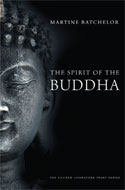 In The Spirit of the Buddha (Yale University Press, 2010, $15.00 paper, 192 pp.), the first volume in a new series from the International Sacred Literature Trust, Martine Batchelor provides commentary on the most fundamental Buddhist teachings and practices as they are found in the Pali canon, the earliest Buddhist sources. Batchelor does this primarily by exploring quotations from Pali translations by Bhikkhu Nanamoli, and in doing so she make the spirit of the historical Buddha accessible to modern English speakers. Don’t let the “spirit” metaphor in the title mislead you, as it is indicative neither of the Buddha’s metaphysics nor Batchelor’s analysis— which is always straightforward, pragmatic, and grounded in her personal experiences as a teacher of Zen and Vipassana meditation. The Spirit of the Buddha is a helpful, fresh reminder of what makes the Buddhist path so attractive.
In The Spirit of the Buddha (Yale University Press, 2010, $15.00 paper, 192 pp.), the first volume in a new series from the International Sacred Literature Trust, Martine Batchelor provides commentary on the most fundamental Buddhist teachings and practices as they are found in the Pali canon, the earliest Buddhist sources. Batchelor does this primarily by exploring quotations from Pali translations by Bhikkhu Nanamoli, and in doing so she make the spirit of the historical Buddha accessible to modern English speakers. Don’t let the “spirit” metaphor in the title mislead you, as it is indicative neither of the Buddha’s metaphysics nor Batchelor’s analysis— which is always straightforward, pragmatic, and grounded in her personal experiences as a teacher of Zen and Vipassana meditation. The Spirit of the Buddha is a helpful, fresh reminder of what makes the Buddhist path so attractive.
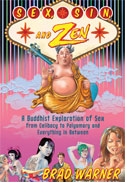 What is the sound of one Zen priest in kinky, carnal ecstasy? In Sex, Sin, and Zen: A Buddhist Exploration of Sex from Celibacy to Polyamory and Everything in Between (New World Library, 2010, $14.95 paper, 304 pp.) Brad Warner—American Zen’s punk rock shock jock of the written word—attempts to write the seminal book about Buddhism and sex. With chapter headings like “Are Buddhists Allowed to Jack Off?” “Filling the Void—If You Know What I Mean! Sex and Emptiness,” and “The Real Porno Buddhist,” Warner, with his trademark irreverence, is hard to take seriously this time. And while this is exactly what he’s going for, his buoyant effort to push the envelope feels forced. He ends up overcompensating for what he correctly perceives as a lack of Buddhist writers able to connect to everyday American Buddhists. This isn’t to say that Warner or Sex, Sin, and Zen is without merit; indeed, what’s frustrating is that Warner and his writing can come across as cocky and half-baked when it’s otherwise clear that he is a compassionate and intelligent teacher. When he addresses topics like prostitution, masturbation, and love from a Buddhist perspective (and mindfulness, enlightenment, and bodhisattvas from a sexual perspective), it is always intimate and entertaining. However, his effort runs only skin deep.
What is the sound of one Zen priest in kinky, carnal ecstasy? In Sex, Sin, and Zen: A Buddhist Exploration of Sex from Celibacy to Polyamory and Everything in Between (New World Library, 2010, $14.95 paper, 304 pp.) Brad Warner—American Zen’s punk rock shock jock of the written word—attempts to write the seminal book about Buddhism and sex. With chapter headings like “Are Buddhists Allowed to Jack Off?” “Filling the Void—If You Know What I Mean! Sex and Emptiness,” and “The Real Porno Buddhist,” Warner, with his trademark irreverence, is hard to take seriously this time. And while this is exactly what he’s going for, his buoyant effort to push the envelope feels forced. He ends up overcompensating for what he correctly perceives as a lack of Buddhist writers able to connect to everyday American Buddhists. This isn’t to say that Warner or Sex, Sin, and Zen is without merit; indeed, what’s frustrating is that Warner and his writing can come across as cocky and half-baked when it’s otherwise clear that he is a compassionate and intelligent teacher. When he addresses topics like prostitution, masturbation, and love from a Buddhist perspective (and mindfulness, enlightenment, and bodhisattvas from a sexual perspective), it is always intimate and entertaining. However, his effort runs only skin deep.
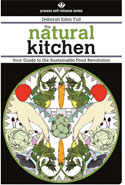 When Buddhists speak of emptiness, it needn’t apply to our stomachs. That’s Deborah Eden Tull’s succulent message in The Natural Kitchen: Your Guide to the Sustainable Food Revolution (Process Self-Reliance Series, 2010, $17.95 paper, 281 pp.), where her Buddhism is inseparable from her love of nature, community, and, most importantly, good food. When Tull invites us to become earth stewards, she may as well be asking us to take the bodhisattva’s vow. “An earth steward,” Tull writes, “is one who recognizes the impact of our lifestyles on the earth and who accepts passionate responsibility for both learning and modeling a more sustainable lifestyle now and for future generations.” These notions of interdependence and nurturing compassion through awareness permeate throughout this hearty book, which grew out of Tull’s experiences as an organic gardener and Zen monk in the foothills of the Sierra mountains in California. Food, the author tells us, is a “we” thing, and that’s evident in the book’s interactive format: in addition to recipes, stories, and instructions for building a sustainable relationship with food, The Natural Kitchen is full of worksheets to be filled out and guiding questions to encourage personal reflection. If you’re interested in taking the earth steward’s vow, pick up this book.
When Buddhists speak of emptiness, it needn’t apply to our stomachs. That’s Deborah Eden Tull’s succulent message in The Natural Kitchen: Your Guide to the Sustainable Food Revolution (Process Self-Reliance Series, 2010, $17.95 paper, 281 pp.), where her Buddhism is inseparable from her love of nature, community, and, most importantly, good food. When Tull invites us to become earth stewards, she may as well be asking us to take the bodhisattva’s vow. “An earth steward,” Tull writes, “is one who recognizes the impact of our lifestyles on the earth and who accepts passionate responsibility for both learning and modeling a more sustainable lifestyle now and for future generations.” These notions of interdependence and nurturing compassion through awareness permeate throughout this hearty book, which grew out of Tull’s experiences as an organic gardener and Zen monk in the foothills of the Sierra mountains in California. Food, the author tells us, is a “we” thing, and that’s evident in the book’s interactive format: in addition to recipes, stories, and instructions for building a sustainable relationship with food, The Natural Kitchen is full of worksheets to be filled out and guiding questions to encourage personal reflection. If you’re interested in taking the earth steward’s vow, pick up this book.
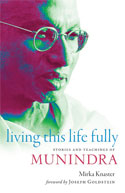 “Munindra’s message is that we can go the distance,” writes Mirka Knaster inLiving This Life Fully: Stories and Teachings of Munindra (Shambhala, 2010, $21.95 paper, 274 pp.), the first book about the highly revered and influential Bengali Vipassana teacher. It’s a testament to Anagarika Munindra’s character that this message comes across so effortlessly on the written page. Though the book includes previously unpublished material from his formal teachings, it’s the stories and memories shared by his devoted students that fully bring Munindra and his dharma to life. Knaster, a scholar, writer, and Vipassana practitioner, skillfully weaves these teachings and personal stories into 16 chapters, each assigned a specific quality of an enlightened being—from mindfulness to equanimity—that Munindra embodied. For Western Vipassana practitioners unfamiliar with Munindra, Living This Life Fullywill serve as a wonderful introduction to a teacher whose students are now household names, for example: Sharon Salzberg, Daniel Goleman, Jack Kornfield, and Joseph Goldstein, who wrote the book’s foreword. This deeply felt, loving portrait of a modern Buddhist master will also inspire those on their own journeys toward actualizing abstract ideals. You can go the distance. The book also includes rare photographs of Munindra.
“Munindra’s message is that we can go the distance,” writes Mirka Knaster inLiving This Life Fully: Stories and Teachings of Munindra (Shambhala, 2010, $21.95 paper, 274 pp.), the first book about the highly revered and influential Bengali Vipassana teacher. It’s a testament to Anagarika Munindra’s character that this message comes across so effortlessly on the written page. Though the book includes previously unpublished material from his formal teachings, it’s the stories and memories shared by his devoted students that fully bring Munindra and his dharma to life. Knaster, a scholar, writer, and Vipassana practitioner, skillfully weaves these teachings and personal stories into 16 chapters, each assigned a specific quality of an enlightened being—from mindfulness to equanimity—that Munindra embodied. For Western Vipassana practitioners unfamiliar with Munindra, Living This Life Fullywill serve as a wonderful introduction to a teacher whose students are now household names, for example: Sharon Salzberg, Daniel Goleman, Jack Kornfield, and Joseph Goldstein, who wrote the book’s foreword. This deeply felt, loving portrait of a modern Buddhist master will also inspire those on their own journeys toward actualizing abstract ideals. You can go the distance. The book also includes rare photographs of Munindra.
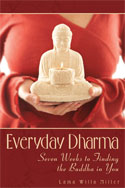 While models like Munindra inspire us to begin our journeys in earnest, it can be confusing to know where to start. Everyday Dharma: Seven Weeks to Finding the Buddha in You (Quest Books, 2009, $15.95 paper, 303 pp.), by Lama Willa Miller, a writer and teacher in the Tibetan tradition, provides a broadly accessible manual for entering dharma practice. In 7 chapters divided into seven days, Miller simplifies the daunting task of finding your own way through the thickets of spiritual pathways. Each day begins with an inspirational quotation to consider (not always from Buddhist sources), which is then followed by a concise passage by Miller on the week’s topic, and the day concludes with an exercise related to the passage. The exercises vary from “Compose an Awakening Prayer” (there is space in the book to do this) to “Adorn Your Sacred Space” to simple meditation practices like “Observe Your Actions.” Occasional “Dharma Tips,” short sidebars scattered throughout the text, elucidate specific details about building your practice. “When you are feeling lost and uncertain,” Miller writes, “take out the tool of the sage’s GPS.” “Sage” is Miller’s translation of bodhisattva, and everything in Everyday Dharmais geared toward guiding beginners to discover their inner sage through a realistic, personalized practice.
While models like Munindra inspire us to begin our journeys in earnest, it can be confusing to know where to start. Everyday Dharma: Seven Weeks to Finding the Buddha in You (Quest Books, 2009, $15.95 paper, 303 pp.), by Lama Willa Miller, a writer and teacher in the Tibetan tradition, provides a broadly accessible manual for entering dharma practice. In 7 chapters divided into seven days, Miller simplifies the daunting task of finding your own way through the thickets of spiritual pathways. Each day begins with an inspirational quotation to consider (not always from Buddhist sources), which is then followed by a concise passage by Miller on the week’s topic, and the day concludes with an exercise related to the passage. The exercises vary from “Compose an Awakening Prayer” (there is space in the book to do this) to “Adorn Your Sacred Space” to simple meditation practices like “Observe Your Actions.” Occasional “Dharma Tips,” short sidebars scattered throughout the text, elucidate specific details about building your practice. “When you are feeling lost and uncertain,” Miller writes, “take out the tool of the sage’s GPS.” “Sage” is Miller’s translation of bodhisattva, and everything in Everyday Dharmais geared toward guiding beginners to discover their inner sage through a realistic, personalized practice.
Thank you for subscribing to Tricycle! As a nonprofit, we depend on readers like you to keep Buddhist teachings and practices widely available.
